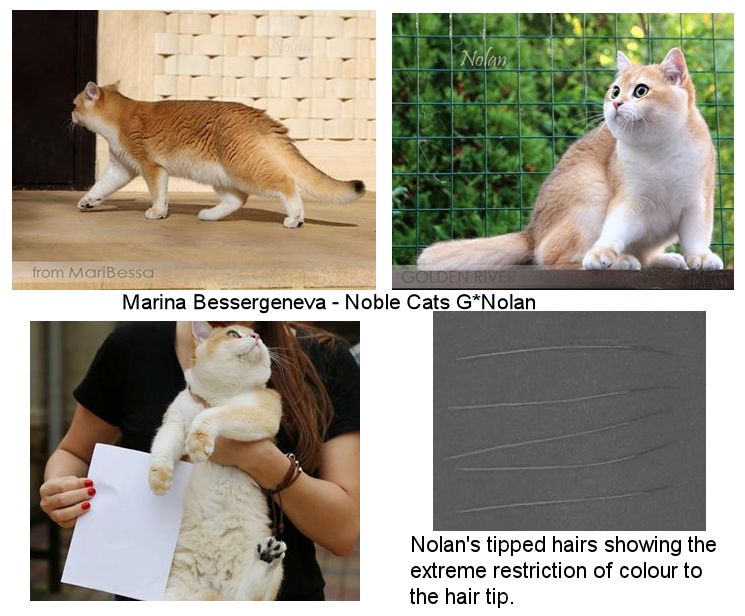
CORIN (VARIABLE WIDEBAND) GENE: COPPER / FLAXEN GOLD / LIGHT GOLD PHENOTYPE IN BRITISH TIPPED SHORTHAIRS/LONGHAIRS
In the early 21st century a new type of "golden" appeared in Tipped and Shaded Golden (Golden Chinchilla and Golden Shell) British Shorthairs. It looked like an "ultra wide-band" effect where the colour was pushed so far to the tips of the hairs that the genetic colour (black, blue, chocolate etc) was barely discernible and the paler areas were almost white. Also many of these cats were warmer in colour. The term "copper" was adopted by Linda Petersson Wahlqvist to describe Golden Shell cats with white toes, white undersides, "warmer" golden colour with the dark tips (e.g. black or blue) restricted to the tail tip and an absence of dark nose-liner. The phenotype deviates from the standard for golden tipped cats but became widespread in Russia and in some German lines of British Golden Shorthairs. It was understood by breeders that there was a recessive inheritance of the assumed gene and Professor Marie Abitbol identified the Corin-gene responsible for this phenotype in British shorthairs/longhairs: British wideband gene (copper).
Breeders sought recognition for this colour and in 2022 this phenotype was approved as "flaxen gold" in WCF and as "copper" in LOOF. Breeders also refer to this phenotype can also be referred to as akita or light golden. Those investigating the genetics usually refer to the phenotype as copper.
There is another phenotype in British shorthair/longhairs that breeders are referring to as (British) sunshine. Those are cats which are much paler than copper and with a warm shimmer. "British sunshine" is not to be confused with sunshine in Siberian cats. Professor Marie Abitbol has tested also such cats for Corin-mutation causing the copper phenotype and they also seem to be homozygote for the "copper-gene" but it is also assumed that there is another gene involved causing their specific phenotype so although they are cop/cop, their phenotype is not the same as copper. The "British sunshine" phenotype is still under investigation.
There are multiple names for this mutation in British Shorthairs/Longhairs.
Copper = akita/urajiro = light gold = flaxen gold = British sunshine (The older term "CORIN gold" was dropped as further CORIN mutations were identified).
Akita/urajiro refers to the strong counter-chading effect in one phenotype. There are different "sunshine" phenotypes.

The new goldens (and related new silvers) British Shorthairs/Longhairs that appeared in Europe were not ny11 (tabby-based goldens), but were ny25 (ticked-based goldens) and attracted a lot of interest in Russia. In adulthood the ticked-based goldens and silvers had extremely uniform tipping with no hint of a tabby pattern. Breeders, particularly in Russia, continued to select the brightest gold chinchillas to breed with and the brightest, most orange, golden cats had pale toes and pale markings around the eyes as well as an ivory belly. This was known as "akita" or "urajiro" by Russian breeders and "copper" elsewhere. Some cats were pale yellowish gold with nearly-white toes. The bleached (or "excessive") version was termed "flaxen gold" by WCF and the light gold (colour of set honey) is also called "British Sunshine" by some breeders but is not the same as the Siberian sunshine mutation. Fans of the colour saw it as a natural evolution of colour to create the perfect golden cat.
From 1st March 2021, associations affiliated with WCF had to segregate the standard golden kittens from the flaxen gold (copper, extreme golden) kittens which have pale bellies and white feet. Different coding on the pedigree keeps the new colour separate from the original golden colour so breeders can decide whether or not to use a Copper/Akita/Light Gold/Flaxen Gold cat in their golden programmes. Until Copper/Akita/Light Gold/Flaxen Gold is officially recognised with its own code, these cats can t compete in the golden class against classic goldens.
There is now the problem that everyone with British sunshine wants the colour to be approved, and ifeir cats are tested cop/cop, they claim it is the same, but Marie Abitbol is still invstigating the idea that the Sushine version could be cop/cop + modifier. There are also a numbe of different "sunshine phenotypes." Another possibility is that there are multiple variants of the copper allele e.g. cop1, cop2, cop3 and that different combinations give the different phenoptypes: cop1/cop1 differing from cop1/cop2, cop1/cop3, cop3/cop3 etc (giving just some of the possible combinations).
NEW CORIN MUTATION IDENTIFIED IN BRITISH SHORTHAIR/LONGHAIR COPPER/FLAXEN GOLD/LIGHT GOLD CATS
This section is a summary of:
Abitbol, M., Dargar, T. & Gache, V. (2022) Golden cats: A never-ending story!. Animal Genetics, 00, 1 4.
The light-gold, akita or copper phenotype was reported by breeders during the 2010s. This modification restricted eumelanin to the tip of the tail and hairs showed a wideband modification. Pedigree analyses showed an autosomal recessive inheritance pattern. The CORIN gene (Corin, serine peptidase) was identified as the strongest candidate, since two CORIN variants had already been identified in Siberian cats with a golden phenotype. A homozygous CORIN:c.2425C>T was identified in copper British cats. All 30 copper cats tested were homozygous for the variant. 20 British control cats were found to be carriers. 340 cats from the 99 Lives dataset did not carry the mutation. 218 cats from 12 breeds also did not have the mutation. CORIN:c.2425C>T is a third variant and represents the wbBSH (British recessive wideband) mutation. A fourth variant has been identified in Bengals - wbBEN is Sorrel in Bengals
The currently known variants of the CORIN gene are:
CORIN:C.839G>A - extreme-sunshine Siberian cats.
CORIN:C.2383C>T - sunshine Siberian cats.
CORIN:C.2425C>T copper/flaxen gold/akita British Shorthair/Longhair cats.
CORIN:C.1759C>T - golden tiger.
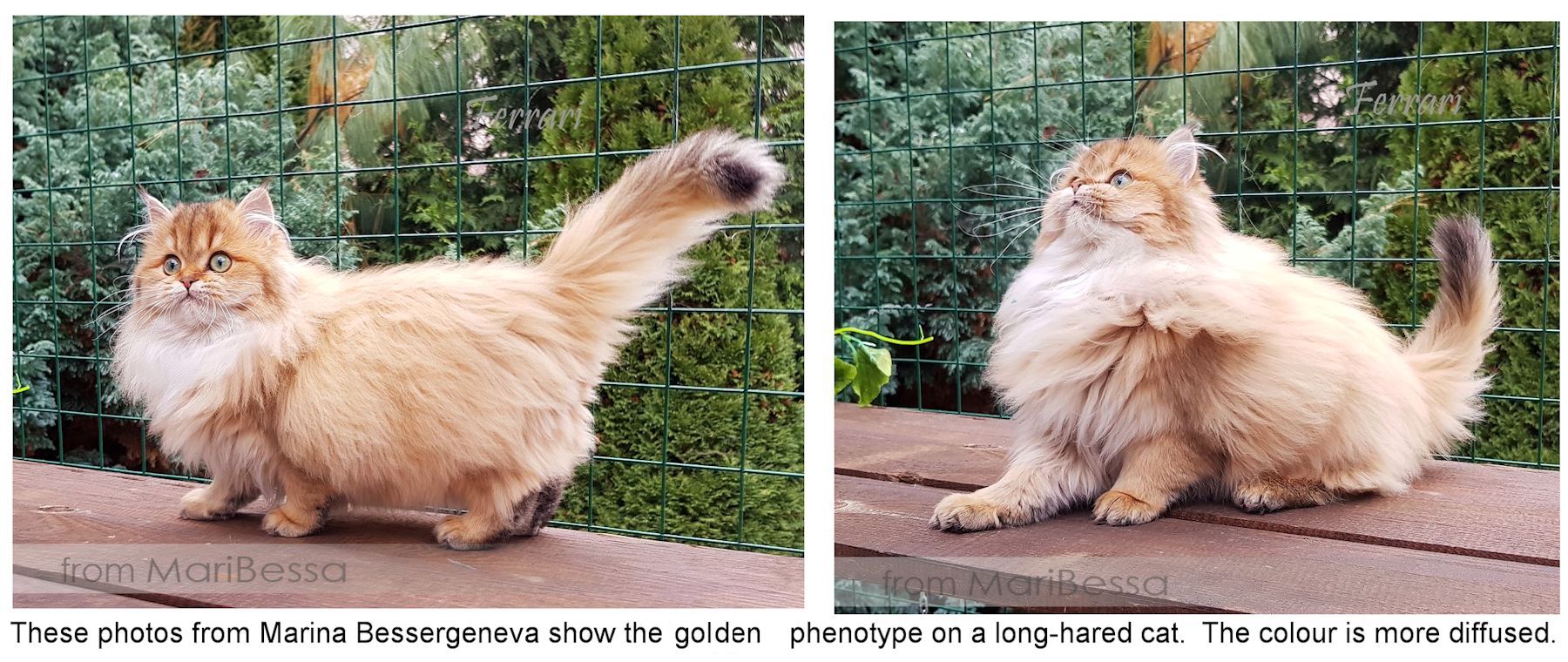
BACKGROUND TO THE COPPER/FLAXEN GOLD/LIGHT GOLD CATS
Tipped and Shaded Golden British Shorthairs (Golden Chinchilla and Golden Shell) are related to Silver series cats. The term "copper" was adopted by Linda Petersson Wahlqvist to describe an extreme phenotype of Tipped Golden with white toes, ivory undersides, golden colour with the dark tips (e.g. black or blue) restricted to the tail tip, and an absence of dark nose-liner. This deviates from the standard for classic tipped golden cats, but became prevalent in Russia and in some German lines of British Golden Shorthairs. Silver chinchillas have the same colour distribution, but we do not see it because "silver" is the absence of pigment! Gold chinchillas from completely different lines had the same effect of "whitening" the breast and other parts. To further split hairs, copper phenotype is reddish with ivory undersides, and there is also a pale gold colour that is the colour of set honey, also with paler underside.
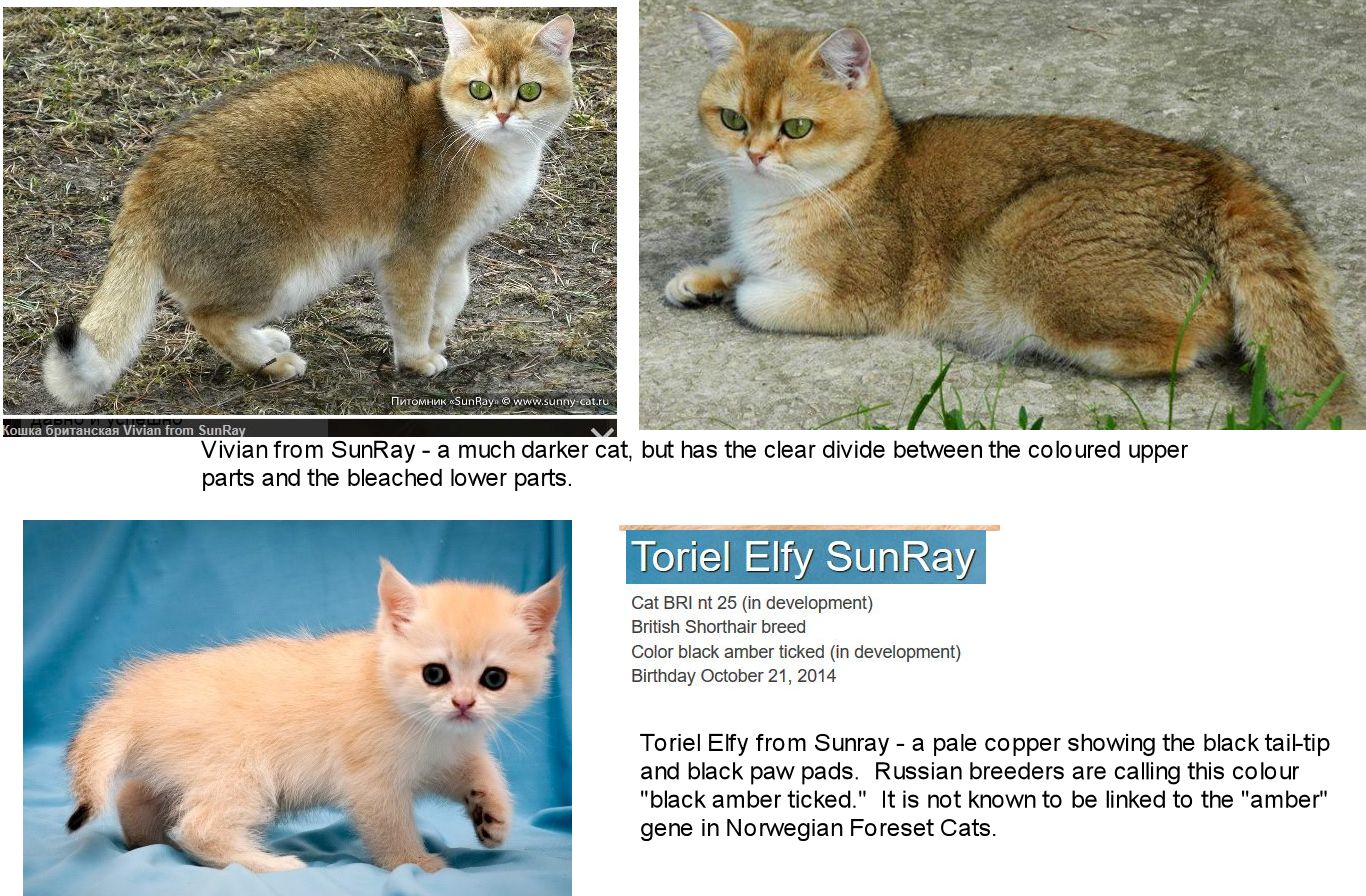
Shaded and tipped (shell/chinchilla) are due to the dominant Inhibitor gene (silver) + Wide Band + Ticked Tabby. Although "Wb" is treated as a single gene for simplicity, there now appear to be different genes in different breeds and there may be other modifiers at play. In ticked tabby cats without silver, Wide Band restricts the pigment to the end of the hair leaving a pale golden band between the skin and the pigment. Through selective breeding, this effect has been maximised. One opinion is that "classic Golden Chinchilla" without the "milky-white" chest is really a shaded colour (not a tipped colour) where black pigment at the hair tips is maximally transformed into red-brown. Unlike the classic golden phenotype, the copper and flaxen gold phenotypes have a sharp dividing line between the reddish colour and the milky-white underparts. This is why Copper/Akita/Light Gold/Flaxen Gold is believed to be the same mechanism as extreme Chinchilla (where reddish pigment is completely suppressed).
Alongside the Copper/Akita/Light Gold/Flaxen Gold phenotypes there are chinchillas where the cats looked white except for the eye colour and paw pads. This shows that the Ultra Wide-Banding effect operates on cats with and without silver. Silver cats without Wide Band are cool-toned ticked tabbies. Golden (ticked) kittens can be born very dark, but become lighter as they mature.
In tipped cats there has been selection for an increase in depigmentation, thus increased/longer depigmented bands. In Copper/Akita/Light Gold/Flaxen Gold the increased depigmentation is milky or peach-gold. The golden zone "overlaps" unnecessary ticking on the hair. Tipping with ultra wide-band is "hidden ticking" - all the colour zones, except for the hair-tip, are masked, although the genes determining them are still present. To get a Copper/Akita/Light Gold/Flaxen Gold also requires full activity of theoretical recessive polygenes to remove pattern i.e. "chaos" and "band frequency" genes. For convenience, we'll consider "chaos" + "band frequency" to be a single trait designated "U". Copper and Flaxen Gold would the theoretical genetic formula A-UUWbBSHWbBSH (Agouti + homozygous U + homozygous CORIN mutation).
Copper tabbies exist, they are uncommon because ticked cats were used in breeding the extreme golden colour that became known as copper. Some sunshine cats show tabby marking, but the markings are more faded than in copper cats without silver. There's a growing consensus amongst geneticists & professional breeders that the copper and silver may interact to enhance the wideband effect. There are very few sunshine and copper with tabby marks because most of cats who were used to produce copper and sunshine kittens are ticked genetically (DKK4 mutations). Corin variants acts with a wideband effect pushing the dark pigment at the tip of the hair. Silver has also a slight wideband effect. The white base of a smoke cat is wider in length that the grey base of a non-silver solid cat.
It is possible that copper + silver add their respective wideband effects to suppress marking. Blotched marked sunshine kittens are genetically blotched + copper + silver. Tabby marked sunshine kittens are genetically tabby + copper + silver

INVESTIGATIVE BREEDING BY KATJA JARIC
Cats bred by Katja Jaric show that copper and British sunshine, and the relationship between the different phenotypes, are not fully understood. Katja s British Longhair boy Bonito (copper/flaxen/British sunshine) tested as cop/cop by Marie Abitbol.
Katja s cats include Top Gun (akita phenotype), tested as cop/cop, but not ny12 (black tipped golden). He was visually ny11 (shaded/flaxen). He also had dark paw pads. Katja found that N/cop were copper carriers, but not akita pattern or British sunshine pattern. She suggested that the akita pattern was due to additional polygenes at other loci. She also suggested there may be other polygenes for the British sunshine pattern at other loci that made them appear golden with silver. Katja bred 16 "sunshine" BRI in 2022 from matings with different colours: ns n/cop - n/n, and ny12 cop/cop - ny11 n/cop.
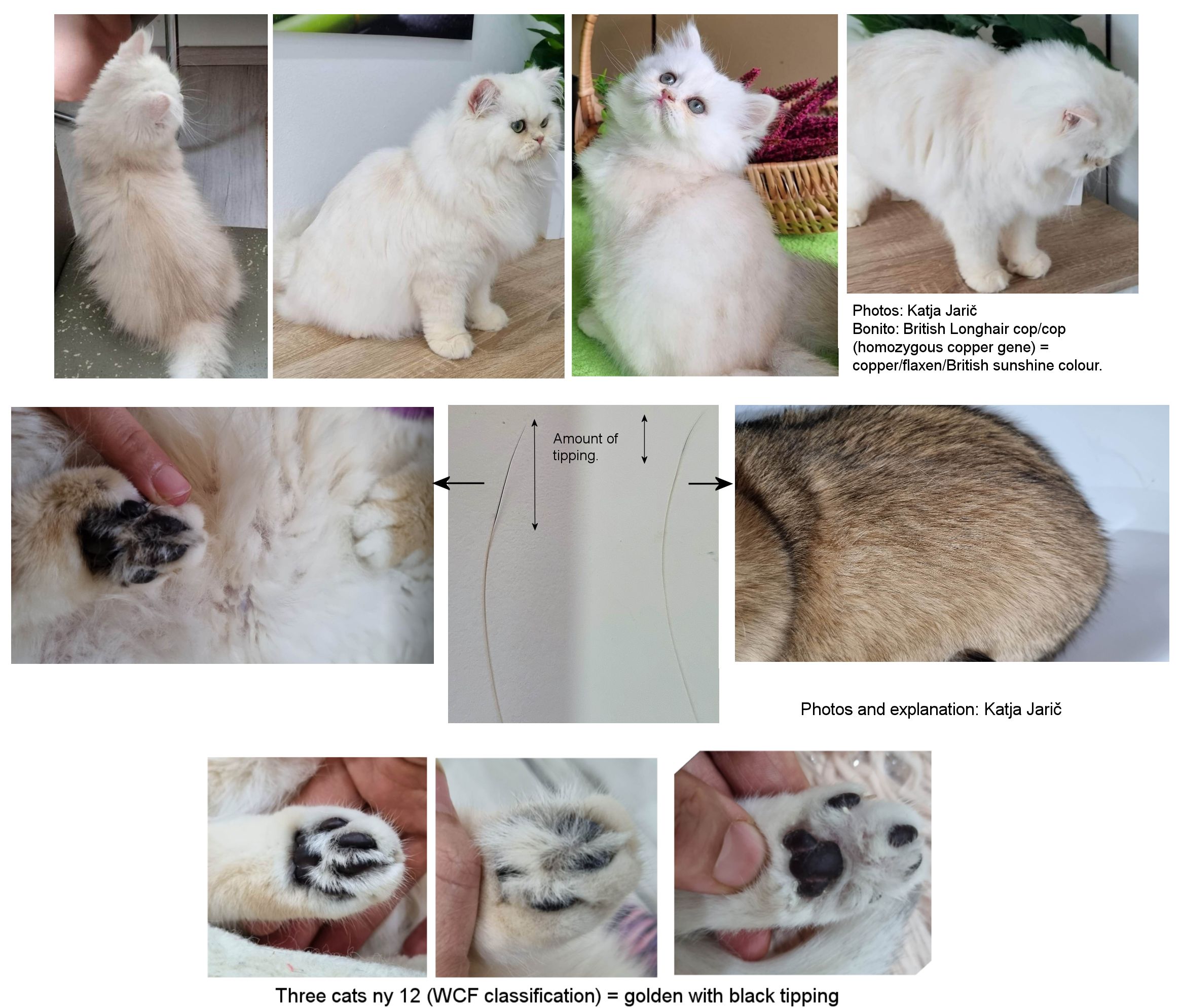
Marie agreed that cop/cop (homozygous) exhibited copper and N/cop (heterozygous, copper carrier) carried copper, but N/cop cats could also appear copper, but with less lightening of the paws. Other N/cop looked like golden ticked without any counter-shading or lightening on the paws. This made polygenes, or multiple copper variants (cop1, cop2 etc) a possibility. Unfortunately breeders register as ny 11 or ny 12 based purely on visual inspection, without a full understanding of the colour. Currently, most breeders don t understand that n/cop are heterozygous (carriers of copper gene) even if they appear to be copper colour themselves.
Currently no-one knows how many Corin genes are present in British Longhairs and Shorthairs. There are 12 variants of the Corin gene in Bengals and there may be multiple variants in the British LH/SH too. The different phenotypes may be due to pairings of different mutations, or may be due to additional polygenes.
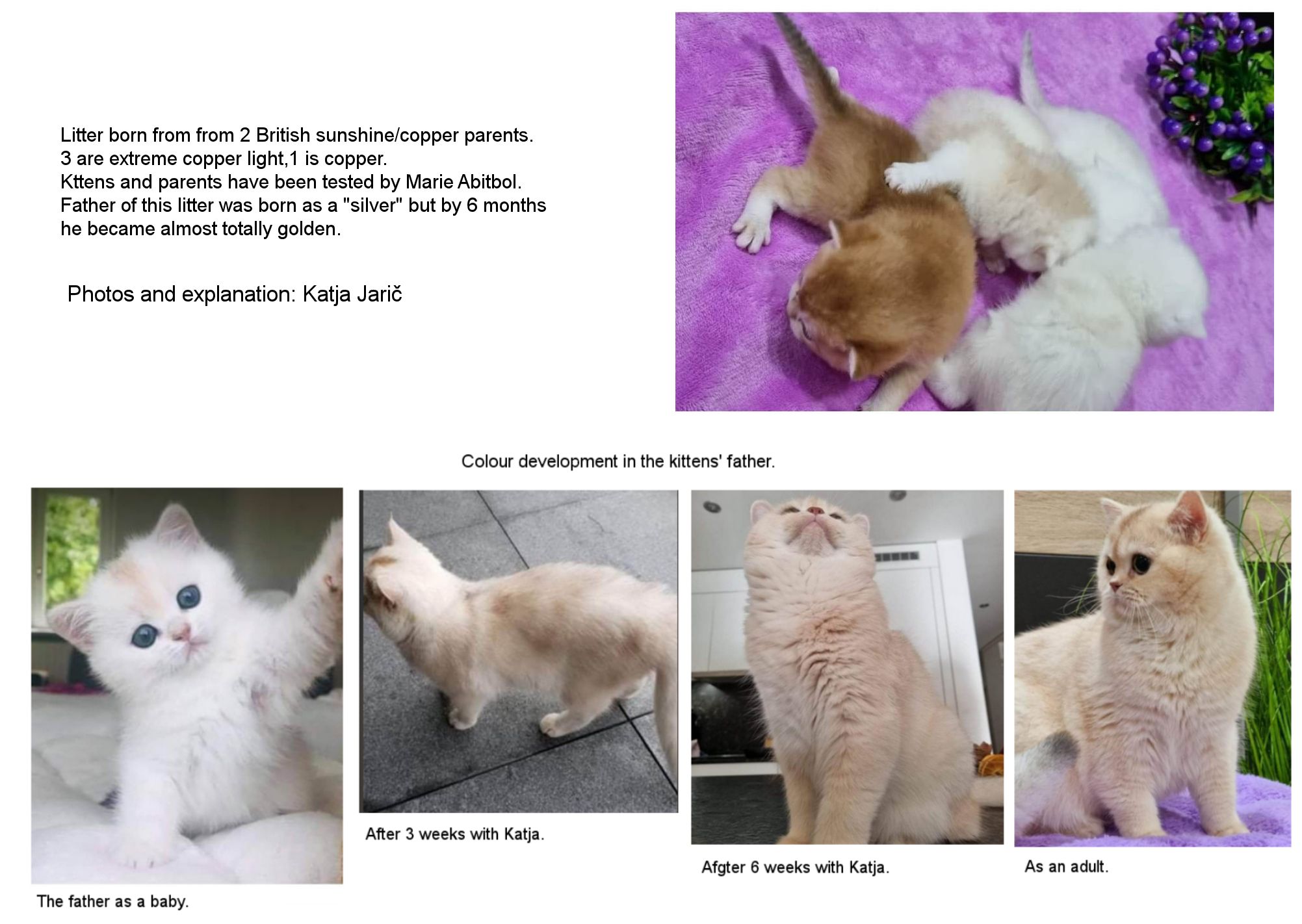
Some cop/cop cats are chinchillas that appear white with no golden on the fur and no black tips at the end of the hair. Only the dark paw pads show that the cats are chinchilla and not white. This seems to be an interaction between the copper gene and the inhibitor (silver) gene - sometimes the inhibitor gene suppresses all golden pigment to give a white cat or very pale chinchilla, sometimes the inhibitor gene doesn't suppress all golden pigment and the cat is British sunshine colour. Kittns also retained the blue eye colour for longer, sometimes not getting their adult eye colour until 12 weeks old instead of the normal 6 - 10 weeks. Katja also found that the colour of a male cat could change according to hormones - he became more silver when active with 6 females. Onve the mating period was over his fur became golden again. As Katja says: These two genes [copper and inhibitor] "fight" with each other even when the cat grows and is already an adult. The color is constantly changing...the question is why? For example, a stud cat Jules Cezar was born silver, turned gold, became more silver again as an adult, and then turned more golden again.
